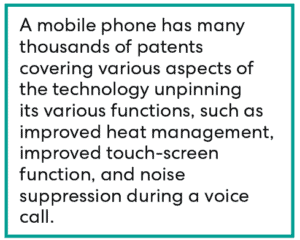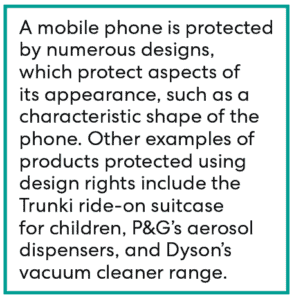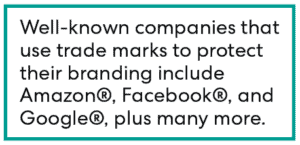Intellectual property (IP) is a form of intangible property that is created using your mind. IP rights provide protection for your IP and can be a valuable asset to both you and your business. You can use your IP rights to stop a third party, such as a competitor, from performing certain acts, including copying your branding or from making, using or selling your invention. It is also possible to sell or license your IP rights, providing a potential revenue source.
IP rights are negative rights, meaning that you have the right to prevent unauthorised parties from using the idea protected by your IP, but not necessarily the right to use the idea yourself.
To understand why, you only need to consider that a piece of technology, such as a mobile phone, may have multiple patents protecting different aspects of it. Even if a manufacturer of a mobile phone has a patent covering a component in the mobile phone, they could potentially be infringing other patents relating to the mobile phone by manufacturing it. Unless the manufacturer obtains licences for those other patents, they risk being sued for infringement.
Patents
A patent is a type of IP right used for protecting an invention, such as a new product or process. In other words, a patent protects the technical aspects of how something works.

A patent may be obtained by filing an application at a patent office, such as the UK Intellectual Property Office (UKIPO) or the European Patent Office (EPO). Typically, it takes around 3 to 5 years to obtain a granted patent, although it can take longer. The process often requires multiple rounds of correspondence with a patent office examiner which, unfortunately, doesn’t always lead to a granted patent.
The potential benefits of obtaining a patent are manifold: opening up new sources of revenue, acting as a deterrent for anyone who might be thinking of entering the market and attracting investors for your business, amongst others. In addition, the protection offered by a patent can include future developments which can open up further licensing opportunities. For example, someone may wish to license your patent protecting “a coffee cup” so that they can manufacture their subsequent invention of “a coffee cup with a handle”.
If you are considering filing a patent application for your invention, take steps to keep your invention confidential before filing. We also strongly advise consulting a patent attorney due to the complex nature and specific requirements of patent specifications.
Designs
Registered designs protect the appearance of a product. Design protection can be obtained relatively quickly (typically several weeks as opposed to several years for patent protection) and is generally cheaper than obtaining patent protection. However, the scope of protection afforded by a registered design right is narrower than for patents, as designs offer protection for a specific implementation of an idea.

In addition to protection using registered designs, the appearance of a product can be protected by an “unregistered design right”. In contrast to a UK registered design right, which can be obtained through an application filed at the UKIPO, a UK unregistered design right takes effect only once the design has been recorded, such as in a design document or by making an article to the design. Similar rights are also available in the EU.
We strongly recommend that you seek professional advice before filing an application for a registered design due to the specific requirements of design applications, to ensure that your design offers the broadest scope of protection available.
For more information relating to designs, please refer to this article.
Trade marks

Trade marks can be powerful tools that enable brands to be recognised. You can use your trade marks to prevent third parties from using your branding, such as your brand name, logos and packaging. In general, a trade mark is a sign which is capable of distinguishing goods or services of one business from another. It can be as simple as a word or combination of words, such as the name of a business or product, or it can be more complex, involving designs, colours, shapes of products or packages, and even sounds.
In the UK, a registered trade mark may be applied for via the UKIPO. You can use a trade mark without first registering it, which, unlike some of the other forms of IP, will not stop you from registering it later. However, it is generally advisable to search for existing trade marks and file a trade mark application before launching a product or service. This is in case there are any other identical or similar trade marks, which may prevent or delay registration.
Obtaining a trade mark registration usually takes around four months, but it can take longer if, for example, your application is opposed by a third party. If a trade mark registration is maintained correctly, it can last indefinitely, subject to renewal every 10 years.
Once you have registered your trade mark, you should take steps to ensure that the trade mark does not become a generic term for a product or service, as this can lead to cancellation of the trade mark registration via “genericide”. A well-known example of genericide is the now cancelled UK trade mark “aspirin”. Similarly, it is important to use a trade mark after it has been registered in order to avoid cancellation of the trade mark due to non-use.
As with the other forms of IP mentioned in this article, we strongly advise you to seek professional advice (e.g., from a trade mark attorney) in relation to your IP needs to ensure that you get the most out of your IP.
Utility models
Utility models can be a useful tool for protecting inventions in some countries. Generally speaking, utility models are easier and cheaper to obtain than patents and can be a good idea for minor modifications of an invention where it may be difficult to obtain a patent. However, the term of protection offered by utility models tends to be shorter than the term of protection available for patents.
Utility model protection is available in a number of European countries, and indeed countries throughout the world, although not in the UK. Utility models go by a number of names, including “short-term patents”, “minor patents” and “innovation patents”. As for the other forms of IP discussed in this article, you have the right to prevent unauthorised parties from commercially exploiting the technology protected by your utility model.
Copyright
In general terms, copyright protects the work of creators of original literary, dramatic, musical and artistic work. This can apply to a range of intellectual or creative works, such as artwork, plays, music, and even databases. Often, a piece of work will be protected by multiple types of copyright. For a recording of a song, there can be separate rights to the lyrics, the performance and the recording. For a novel, there can be separate rights to the text and the way the text is arranged on the page.
Copyright comes into existence as soon as you create the work, and typically lasts for 70 years from the end of the year in which you die, though this can vary depending on a number of factors.
Due to an international convention known as the Berne Convention, obtaining copyright in one country usually means that people cannot copy your work in other countries without infringing your rights. This is unlike other forms of IP, where, generally speaking, rights are territorial (i.e., obtained on a country-by-country basis). To date, there are over 175 contracting states throughout the world in which the Berne Convention applies.
As a copyright owner, you can license your copyright to obtain a financial benefit for your work and prevent unauthorised parties from dealing with your copyright without your consent. You also have moral rights giving you the right to, for instance, be recognised as the author of a work.
Trade secrets, confidential information and know how
A trade secret refers to commercially valuable information which is, as the name suggests, kept secret. To qualify, the information must not be generally available or accessible to those working within the relevant circles. Maintaining information as a trade secret can often provide a competitive advantage. A trade secret does not need to be registered, but reasonable steps must have been taken to keep it a secret, such as clauses in employment contracts, non-disclosure agreements and password-protected documents. We are able to advise on how best to protect your trade secrets and confidential information.
A trade secret can last for an unlimited period of time and provides protection against anyone, including employees, disclosing the information. However, in contrast to patents, a trade secret does not provide any protection against someone independently discovering, or even reverse engineering, the information.
A well-known example of a trade secret is the Coca-Cola® recipe, which has been a closely guarded secret since the recipe was first created over 100 years ago. This far exceeds the duration of any patent which could have been filed for the recipe when it was first created. Information of this sort can be of immense value, and it can be worth taking significant steps to keep the information secret.
Sources of Further Information and Advice
This is for general information only and does not constitute legal advice. Should you require advice on this or any other topic then please contact hlk@hlk-ip.com or your usual HLK advisor.
A PDF of this information can be accessed here.